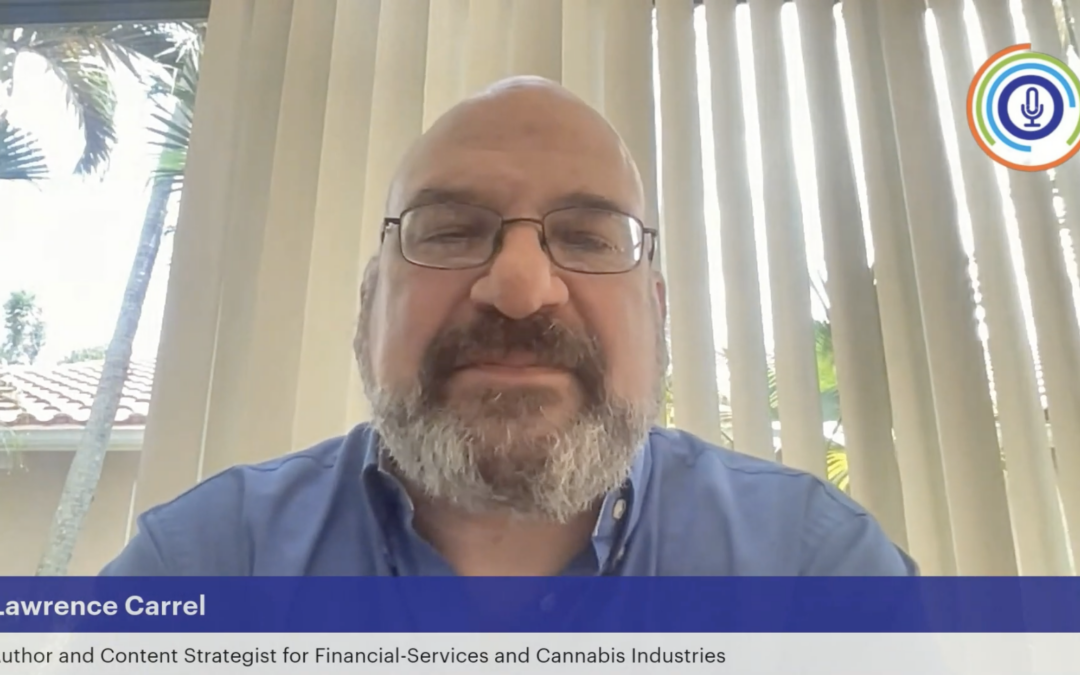In an era of rapid media and communication shifts, Lawrence “Larry” Carrel’s transition from financial journalism to content strategy demonstrates the adaptability and foresight required to thrive. A veteran journalist and part of the pioneering team at wsj.com, Carrel has transitioned to a role where he enhances financial communication through strategic storytelling. He is an author, copywriter and content strategist for financial-services and cannabis Industries.
Larry founded Long Run Consultants in 2008 after the financial crisis, which upended the financial industry. His career path provides invaluable insights into the enduring value of effective communication even in today’s changing media landscape, emphasizing the importance of long-form writing writing and the integration of journalistic rigor into content strategy in a world where companies must produce their own content.
Larry’s seen some of the great Rock ‘n Roll bands so you don’t want to miss the video below where he talks about The Who, Bruce, Grateful Dead and almost meeting Elvis Costello at Madison Square Garden.
Foundation of a Financial Journalist in Content Strategy
Carrel’s career launched in the early days of online journalism. “I started out in journalism and I was on the team that helped build wsj.com back in the early days with the internet,” he recalls. His tenure at The Wall Street Journal and subsequent roles at Smart Money and TheStreet.com solidified his expertise in financial journalism, sharpening his analytical skills and deepening his understanding of financial markets. However, he soon noticed a disturbing trend.
One significant lesson Larry Carrel learned from his experience as a financial journalist is the critical importance of making complex information accessible and understandable to a broad audience. His work involved distilling detailed financial data and jargon-heavy content into clear, engaging stories that could be comprehended by readers who may not have a background in finance.
“Journalism has definitely been getting less respect by the people that own the journalistic outlets. They don’t want to put money into paying the people,” he notes.
This lack of respect and remuneration steered him towards freelancing when it was “very hard to find a job in journalism.”
In spite of the decline of journalism opportunities, these lessons from his career in financial journalism have shaped his approach in his current role as a content strategist, where he continues to emphasize clarity, engagement, and the power of a well-told story to connect with and educate audiences.
Transitioning from Journalism into Content Strategy
This career shift allowed Carrel to apply his journalistic skills in a new context—helping financial firms articulate complex concepts to their clients. “I decided I would write, I knew a lot about finances… so I started trying to get jobs from the actual financial services companies that I had talked to as a journalist,” he explains.
His unique value proposition is making the complex world of finance accessible and engaging: “And basically I help them sound brilliant. And so what I do is, when they want to write something, but they don’t want to actually sit down and write it, they give me a call and I write it for them.”
The growing demand for such skills mirrors broader labor market trends. “What’s interesting is your experience tracks the labor markets. And I say that because the employment in journalism over the last 15 years has gone down and, PR and marketing and writing kinds of jobs have exploded,” Carrel points out.
The Power of Storytelling
At the core of Carrel’s approach to content strategy lies a deep understanding of human cognition and learning.
“Humans are very set. Our minds are set to absorb stories. That’s a good way to learn. That’s how they teach kids, is by telling them stories,” he states.
This insight is crucial for financial advisors and firms aiming to connect effectively with their audience. Carrel stresses that storytelling is essential for engaging communication.
“The being a journalist, you’re coming from journalism. You understand that story is really the key thing,” he asserts.
By crafting narratives, he keeps clients engaged: “You have to put everything into a story and that keeps people’s interests. Whereas if you’re just reciting facts and all that, people start falling asleep on you.”
His method involves framing financial data in narratives that make quarterly reports and market analyses relatable and digestible.
“I write about the funds for them that they can use in their marketing. I write newsletters for them to send to their clients,” Carrel details, showing his role in transforming dry data into compelling stories.
Carrel extends his storytelling beyond article creation, helping clients recognize the narrative’s value in their communications for example, when: “new systems are put into place to make [something] happen. So that’s very important and you have to bring that story to people.”
His proactive approach in identifying and emphasizing relevant yet underreported stories proves invaluable in a fast-evolving market where you want to differentiate from the competition.
Furthermore, he ensures the message’s authenticity often comes directly from the clients: “When I’m talking to clients, I’m not really picking too much for them. They’ve got something they want to say. So I let them tell me what the story should be.”
Want Good Content Strategy? Take Out the Jargon
Carrel’s professional writing experience is also evident in his practical approach to writing and client relationships. He has learned to detach from the sanctity of his words, a vital skill in a collaborative setting: “And being a journalist, you learn not to be married to any of your words because you have all these editors who are picking it over.”
Carrel’s journalistic background aids him in demystifying financial jargon: “It’s like translating legalese into regular English. And as working as a journalist, I was able to do that, translate it and take out the jargon and take out all the key, the buzzwords that don’t always mean something and try to actually put like a word that has meaning to it.”
His capability to address diverse audiences further enhances his effectiveness: “You’ve got to be able to write to different audiences.” The this diversity highlights the importance of storytelling as a tool to engage and educate audiences based on where they are coming from. For example, a fund needs to communicate the same information differently to individual investors, wealth managers and regulatory officials.
He highlights the importance of tracking economic and financial trends in storytelling: “What the federal reserve does is very important and how the money is moving in the economy and how the economy is doing and what the labor market is doing,” all provide the contexts for the numbers.
Having a comprehensive understanding of the economic, social and political context that influences business decisions is important to the financial storytelling. Why? Who? What? and How? the money moves.
Living the NYC Rock and Roll Scene
Larry’s professional journey in the realms of journalism and content strategy is punctuated by his experiences with the vibrant rock and roll scene of New York City. His passion for classic rock provided a respite from his demanding career. Carrel’s musical interests, ranging from The Who and The Beatles to Pink Floyd and Bob Dylan, reflect his deep appreciation for storytelling through music—a skill that translates seamlessly into his professional work.
Carrel shared some great stories. He saw The Who in Buffalo the day after the tragedy in Cincinnati where several people were trampled. He’s see the Grateful Dead several times and Bruce Springsteen several times: “Always puts on a good show.”
At a Madison Square Garden concert, Larry and his girlfriend found themselves in a serendipitous elevator ride that would become a memorable story, albeit one of missed connections. As they exited the vast freight elevator, primarily used for moving heavy stage equipment, standing conspicuously among a few others was Elvis Costello, a figure whose music had colored many a New Yorker’s life with its lyrical genius and distinctive style.
Carrel, recognizing the rare opportunity, quickly thought of a playful way to engage. Larry recalled the moment with a hint of humor: “I say to her, we should talk to him and tell him your name’s Allison.” However, the moment was not to be. His girlfriend, perhaps overwhelmed by the suddenness of the encounter or the potential awkwardness of the situation, communicated her preference for discretion. He respected her wish, “so I did not exactly talk to Elvis Costello, though he was standing there staring at me.”.
Reflecting on the incident, Larry mused with a chuckle about the nature of missed opportunities and the stories they become, stories that remind us that even in small moments, there is a narrative waiting to be told.
Attending numerous concerts and immersing himself in the energy of live performances, Carrel gained a firsthand understanding of how musicians connect with their audience, craft their personas, and create memorable experiences. Moreover, his extensive experience with New York’s rock scene has given Carrel a unique perspective on the evolution of media and public engagement. Just as rock and roll has had to adapt to changes in the music industry, Carrel has navigated the shifting landscapes of journalism and content strategy.
It’s a Satisfying Trade
Reflecting on his journey, Carrel finds profound satisfaction in his work, akin to the thrill of journalism: “And I, When you get a, when you get a scoop, you just get the adrenaline running, but even so having something to do every day and just sitting down and writing and feeling like you’re producing something that’s helpful to people, especially if you’re writing about personal finance.”
Lawrence Carrel’s shift from journalism to content strategy illustrates how effectively communicating financial and technical information in today’s digital storytelling-driven era is vital. His experience underscores the critical role of narrative in engaging and educating audiences, proving that complex topics can become accessible and compelling through well-crafted storytelling.
SMarketPlace™ Live – PublioSTUDIO™ and The Podcast Ecosystem™
SMarketPlace™ Live on LinkedIn is a product demonstration for Publio’s Podcast Ecosystem™. This thought leadership and lead generation service connects your podcast to a network of blog posts, social media and email marketing to drive traffic into a CRM-linked content hub. The goal is to market and distribute integrated content to fully activate your network via social media and amplify your SEO. Interested in launching a Podcast Ecosystem for your business? Learn about the offering MarTech recently named “What’s new and what’s working, in B2B Channel Partner Marketing” and contact us to inquire about how you can get started with your own podcast ecosystem.


